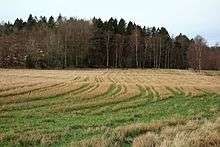Crop residue

There are two types of agricultural crop residues. Field residues are materials left in an agricultural field or orchard after the crop has been harvested. These residues include stalks and stubble (stems), leaves, and seed pods. The residue can be ploughed directly into the ground, or burned first. Good management of field residues can increase efficiency of irrigation and control of erosion. Process residues are materials left after the crop is processed into a usable resource. These residues include husks, seeds, bagasse, molasses and roots. They can be used as animal fodder and soil amendment, fertilizers and in manufacturing.
Economic value
Most discussions about the economic value of crop residues focus on the equivalent fertilizer cost of the nutrients within. Although crop residues contain both macro- and micro nutrients, only values for the macro nutrients nitrogen, phosphorus, potassium and sulfur are economically significant.
Mineralogist
Nutrients in most crop residue are not immediately available for crop use. Their release (called generalization) occurs over a period of years. The biological processes involved in soil nutrient cycles are complex. As a rough guide, cereal straw releases about 10 to 15 per cent of its nutrients and pea residues release about 35 percent of their nutrients by the next year.
The speed of generalization depends on the nitrogen and lignin (fiber) content, soil moisture, temperature, and degree of mixing with the soil. N is released fairly quickly from residue when the content is higher than 1.5 per cent (such as in pea residues). In contrast, below 1.2 per cent (such as cereal residue), soil-available N is fixed (called immobilization) by the microbes as they decompose the residue.
Thus pea residue would have short- and long-term benefits to soil fertility, whereas cereal straw would reduce next year's soil supply of available nutrients. Over time, the nutrients fixed by soil microbes and humus are released and available to crops. Nutrients from residue are not fully recovered by crops. Just like fertilizer nutrients, nutrients released from crop residue into the soil are susceptible to losses such as leaching (N and S), denitrification (N), immobilization (N, P, K and S), and fixation (P and K).
Efficiency of nutrient uptake
The efficiency of nutrient uptake by crops from fertilizers or residue release is generally thought to be similar. For example, about 50 percent recovery of N in the above-ground plant in the first year. There is some residual benefit of fertilizers as the crops take up a small amount of the nutrients two and three years later. Fertilizer placement can significantly affect the efficiency of crop uptake. The impact of residue placement (buried by tillage or left on the surface in zero tillage) on nutrient cycling and efficiency is under study.
Thus, the practice of calculating the fertilizer equivalent value of the nutrients in crop residue is a reasonable guide to estimating the partial value of crop residues.
See also
References
- Alemayehu Mengistu. 1985. Feed resources in Ethiopia. A paper presented at the Workshop on Animal Feed Resources for Small Scale livestock Producers, 11–15 November 1985, Nairobi, Kenya. 12 pp.
- Butterworth, M.H. and Mosi, A.K. 1986. The voluntary intake and digestibility of combinations of cereal crop residues and legume hay for sheep. ILCA Bulletin 24:14-17.